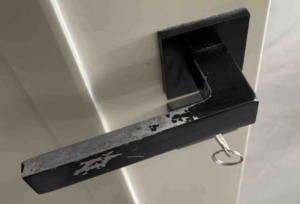Powder coating is a widely used surface finishing technique in the door hardware industry, known for its durability, aesthetic appeal, and environmental benefits. However, one common issue manufacturers and buyers often encounter is powder coating peeling off after application. This problem can lead to dissatisfied customers, increased costs, and production delays. In this blog, we’ll explore the root causes of powder coating peeling and how to address them effectively.
What is Powder Coating?
Powder coating is a dry finishing process where electrostatically charged powder particles are sprayed onto a surface. The coated object is then cured in an oven, where the powder melts and forms a smooth, hard, and durable finish. This process is widely used for coating door hardware components such as mechanical locks, door handles, hinges, and closers.
The key advantages of powder coating include:
- Superior durability and resistance to corrosion, scratches, and UV rays.
- A wide range of colors and finishes.
- Environmentally friendly, as it produces minimal volatile organic compounds (VOCs).
However, despite its many benefits, powder coating can sometimes fail, leading to issues like peeling. Let’s dive into the main reasons behind this problem.

Common Causes of Powder Coating Peeling and How to Prevent It
1. Poor Curing Process
Proper curing is essential for achieving a strong bond between the coating and the metal substrate. If the powder coating is not fully cured, it will not adhere properly, leading to premature peeling.
Two common curing issues include:
- Inconsistent Oven Temperature: If the curing oven temperature is too low or uneven, the powder coating will not fully polymerize, reducing adhesion. Manufacturers should regularly monitor and calibrate oven temperatures to ensure uniform curing.
- Improper Thickness Adjustments for Different Substrates: Thick and thin metal parts require different curing times and temperatures. If treated the same way, thinner parts may overcure while thicker ones remain undercured. Adjusting curing parameters based on material thickness ensures proper adhesion and durability.
✅ Solution: Regularly test oven temperatures using temperature profiling tools and adjust curing times based on the specific properties of the coated material.
2. Incorrect Powder Coating Formulation
The composition of the powder coating itself plays a significant role in adhesion and durability. The ratio of resin to hardener (curing agent) must be correctly balanced to ensure optimal performance.
Key formulation issues that can cause peeling:
- Incorrect Resin-to-Hardener Ratio: If the formulation is not well-balanced, the coating may be too brittle or too soft, leading to weak adhesion.
- Incompatibility with Certain Substrates: Some powder coatings work well on cold-rolled steel but may not adhere properly to galvanized or stainless steel surfaces.
✅ Solution: Manufacturers should carefully calculate and adjust the formulation to match the specific substrate. It’s essential to conduct adhesion and flexibility tests to ensure coating performance on different materials.
3. Substrate Compatibility Issues
Different metal substrates require different powder formulations and surface preparation methods. Using the wrong type of powder coating for a specific metal surface can result in weak adhesion and peeling.
Examples of substrate-related peeling issues:
- Cold-Rolled Steel (CRS): Generally provides good adhesion, but requires proper cleaning and degreasing.
- Hot-Rolled Steel (HRS): Has a rougher surface and may require additional preparation, such as sanding or priming.
- Galvanized Steel (Hot-Dip & Electro-Galvanized): Zinc coatings can interfere with adhesion if not pretreated correctly. Certain powder coatings do not bond well with zinc surfaces.
- Stainless Steel: Naturally smooth and corrosion-resistant, making adhesion more challenging without special primers or etching.
- Fingerprint-Resistant Coatings: Some specialized coatings may prevent powder from bonding properly, requiring additional surface treatments.
✅ Solution: Choose a powder coating formulation that matches the specific metal substrate. Conduct adhesion tests on different materials before full-scale production.
4. Inadequate Surface Preparation (Pre-Treatment Issues)
Proper pre-treatment is one of the most critical steps in powder coating. If contaminants remain on the surface before coating, the adhesion will be weak, leading to peeling over time.
Common pre-treatment problems:
- Failure to Remove Oils and Grease: Residues from machining or handling create a barrier between the powder and the metal.
- Improper Use of Chemical Treatments: Acid washes, phosphate coatings, or other treatments must be correctly applied to enhance adhesion.
- Insufficient Rinsing: Chemical residues left on the surface can react with the powder during curing, leading to adhesion failures.
✅ Solution: Implement a thorough pre-treatment process, including degreasing, rinsing, and drying. Ensure consistency in chemical application and check adhesion strength after treatment.
Conclusion
Powder coating peeling is a multifaceted issue that can stem from inadequate curing, incorrect powder formulation, or poor surface preparation. By addressing these factors, manufacturers can significantly improve the quality and durability of their powder-coated products.
For buyers in the door hardware industry, understanding these challenges can help you make informed decisions when selecting suppliers. Look for partners who prioritize quality control, use advanced equipment, and deeply understand powder coating chemistry and processes.
At UMAY, we are committed to delivering high-quality powder-coated door hardware that meets the highest standards of durability and aesthetics. Contact us today to learn more about our products and how we can support your business needs.
Share This Story, Choose Your Platform!

